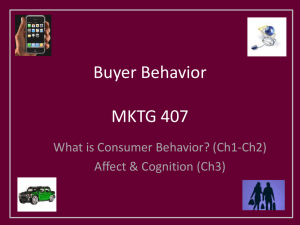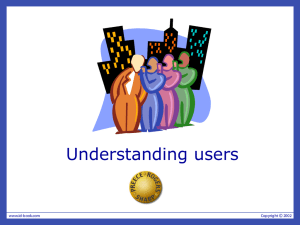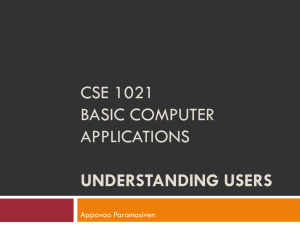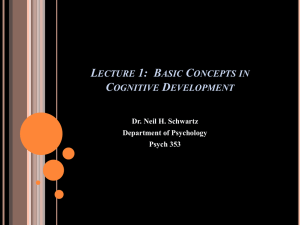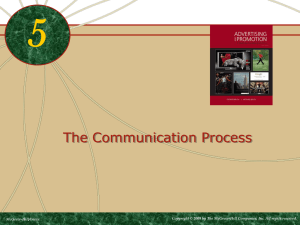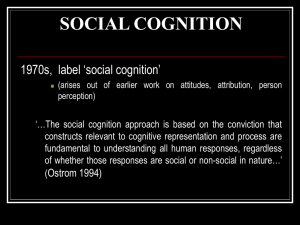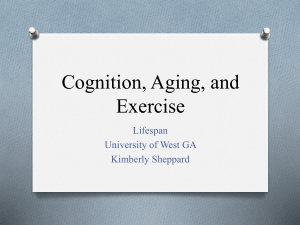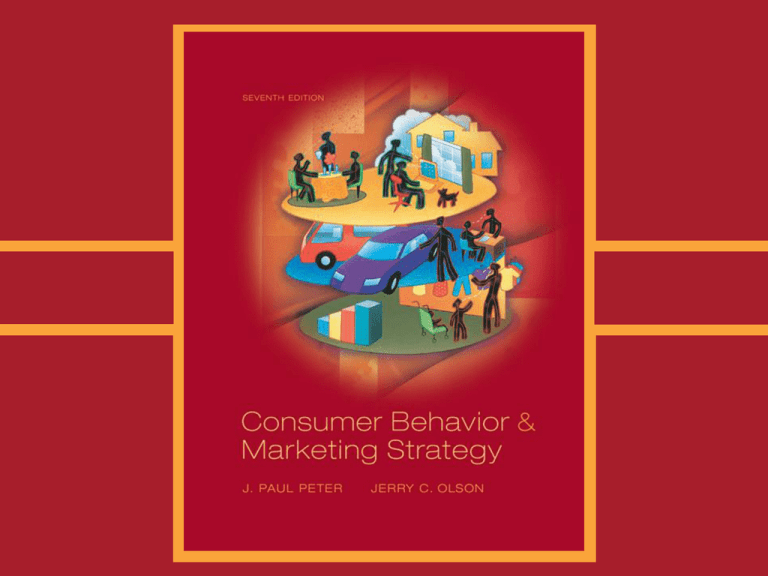
Chapter 3
Introduction to Affect
and Cognition
McGraw-Hill/Irwin
Copyright © 2005 by The McGraw-Hill Companies, Inc. All rights reserved.
Components of the Wheel of Consumer
Analysis
3-3
Components of the Wheel of Consumer
Analysis
• Environmental factors
• Behavioral influences
• Marketing strategies and stimuli
3-4
Affect and Cognition as Psychological
Responses
• Two types of mental responses to stimuli
and events in the consumer environment
– Affect
• Feeling responses
– Cognition
• Mental responses
• Types or levels of affective responses
– The types of affect differ in the level of bodily
arousal or intensity with which they are
experienced
3-5
Affect and Cognition as Psychological
Responses cont.
3-6
Affect and Cognition as Psychological
Responses cont.
• The affective system
– Five basic characteristics of the affective
system
•
•
•
•
The system is reactive
Lack of direct control over affective responses
Affective responses are felt physically in the body
The system can respond to virtually any type of
stimulus
• Most affective responses are learned
3-7
Affect and Cognition as Psychological
Responses cont.
• What is cognition?
– Understanding
– Evaluating
– Planning
– Deciding
– Thinking
3-8
Affect and Cognition as Psychological
Responses cont.
– Major function of people’s cognitive system is to
interpret, make sense of, and understand
significant aspects of their personal experiences
– Second function of cognitive system is to
process interpretations or meanings in carrying
out cognitive tasks
3-9
Affect and Cognition as Psychological
Responses cont.
• Relationship between affect and cognition
– Differing views among researchers
•
•
•
•
Affective and cognitive systems are independent
Affect is largely influenced by the cognitive system
Affect is the dominant system
Affective and cognitive systems are highly
interdependent
3-10
Affect and Cognition as Psychological
Responses cont.
3-11
Affect and Cognition as Psychological
Responses cont.
– Each system can respond independently to
aspects of the environment
– Each system can respond to the output of the
other system
3-12
Affect and Cognition as Psychological
Responses cont.
• Marketing implications
– Both affect and cognition are important for
understanding consumer behavior
– Affective responses are especially important for
so-called feeling products
3-13
Affect and Cognition as Psychological
Responses cont.
• Using metaphors to communicate affective
and cognitive meaning
– Metaphors can communicate both cognitive and
affective meanings about a brand or company
3-14
Cognitive Processes in Consumer
Decision Making
• Information-processing models
– Used to identify sequence of cognitive
processes
– Consumer decision making involves three
important cognitive processes
• Interpretation
• Integration
• Retrieval of product knowledge from memory
3-15
Cognitive Processes in Consumer
Decision Making cont.
• Consumer decision making model
3-16
Cognitive Processes in Consumer
Decision Making cont.
– Interpretation processes
• Attention
• Comprehension
• Knowledge, meanings, and beliefs
– Integration processes
• How consumers combine different types of
knowledge to form overall evaluations of products,
other objects, and behaviors
• Choose among alternative behaviors
3-17
Cognitive Processes in Consumer
Decision Making cont.
– Product knowledge and involvement
• Stored knowledge, meanings, and beliefs
• Product involvement
• Additional characteristics of the cognitive
system
– Activation of memory
– Unconscious thinking
– Spreading activation
3-18
Cognitive Processes in Consumer
Decision Making cont.
– Limited capacity
– Automatic processing
• Marketing implications
– Need to understand how consumers interpret
marketing strategies
– Consumer integration processes critical
– Activation of product knowledge
3-19
Knowledge Stored in Memory
• Types of knowledge
– General knowledge of environment and
behaviors
• Propositions
• Episodic knowledge
• Symantic knowledge
– Procedural knowledge about how to do things
• “If…then…” proposition
3-20
Knowledge Stored in Memory cont.
• Structures of knowledge
– Associative networks
3-21
Knowledge Stored in Memory cont.
– Types of knowledge structures
• Schemas
• Scripts
– Marketing implications
• Cognitive learning
– Direct personal use experience
– Vicarious product experiences
– Interpret product-related information
3-22
Knowledge Stored in Memory cont.
– Results of information interpretation
•
•
•
•
Accretion
Tuning
Restructuring
Marketing implications
3-23
Summary
• Important internal factors of affect and
cognition and the affective and cognitive
systems were introduced
• Identified four types of affective responses
ranging from emotions to specific feelings to
moods to evaluations
3-24
Summary cont.
• Described the cognitive system and the
various types of meanings it constructs
• Emphasized that the two systems are highly
interrelated and the respective outputs of
each can elicit responses from the other
• Presented a model of the cognitive process
involved in consumer decision making
3-25
Summary cont.
• Discussed the content and organization of
knowledge as associate networks or
knowledge structures
• Described how meaning concepts are linked
together to form propositions and
productions that represent general
knowledge and procedural knowledge
• Two types of knowledge structures were
described
3-26



